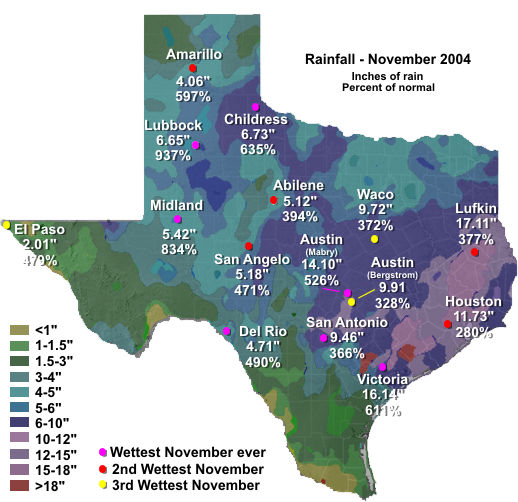Article courtesy of National Weather Service Southern Region Headquarters News
November has now taken its place in the record books as the wettest November in Texas since comprehensive record keeping began in 1895 -- and 2004 may also turn out to be the state's wettest year. According to preliminary data from the NOAA National Weather Service Southern Region Climate Center in Baton Rouge, La., November averaged 6.08 inches of precipitation across the state (previous record - 5.71 inches in 1902).
Major cities throughout the state also accumulated record November rainfall totals that ranged from three and a half to nearly ten times the norm (based on 30 year rainfall averages). According to data compiled by NWS Southern Region Weather Forecast Offices, the following Texas cities set new records for the month of November:
* Austin - 14.10" (previous record: 10 inches in 2001) or 526% of the norm
* San Antonio - 9.46" (previous record: 9.16" in 1874) or 366% of the norm
* Lubbock - 6.65"(previous record: 3.45" in 2001) or 937% of the norm
* Midland - 5.42" (previous record 2.32' in 1968) or 834% of the norm
* Lufkin - 17.11" (previous record 15.97" in 2000) or 377% of the norm
* Victoria - 16.14" (previous record 10.11" in 1998) or 611% of the norm
* Childress - 6.73" (previous 4.29" in 1992) or 635% of the norm
* Del Rio - 4.71" (previous record 4.54" in 1913) or 490% of the norm
Residents of Houston, Amarillo, San Angelo and Abilene, Texas experienced their second wettest November on record - while Waco and El Paso had the third wettest. The record rainfall covered most of the state, leaving only the extreme northeast and extreme south with below normal precipitation for the month. As unusual as this November has been, it is actually the second month to achieve the wettest month designation this year. June 2004 was also the wettest June on record in Texas.

NWS Southern Region Climate Services Program Manager Victor Murphy attributes the record rainfall to two persistent weather patterns. "A moist southeast flow from the Gulf at the lower levels of the atmosphere has been combining with a southwest flow aloft that has been pumping in moisture from the Pacific Ocean," he said. "These larger scale features, combined with surface cold fronts and surface troughs, triggered the record precipitation."
Ironically, these record rainfall totals have been achieved without the aid of any tropical systems. There were no land falling tropical systems in Texas this year.
As to the future, Murphy says a developing weak to moderate El Niño pattern in the central Pacific Ocean should signal a greater than normal chance of above average rainfall across Texas during the winter and spring months. To date, preliminary data shows Texas as a whole has accumulated in excess of 39 inches of precipitation. That makes 2004 the state's third wettest year on record and a contender to break the current annual record of 41.93 inches set in 1919. Texans will just have to wait and see what December has in store for them.